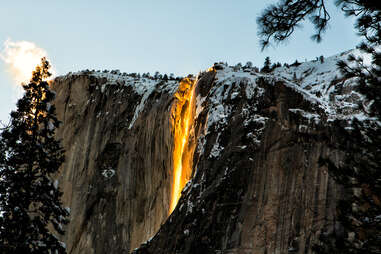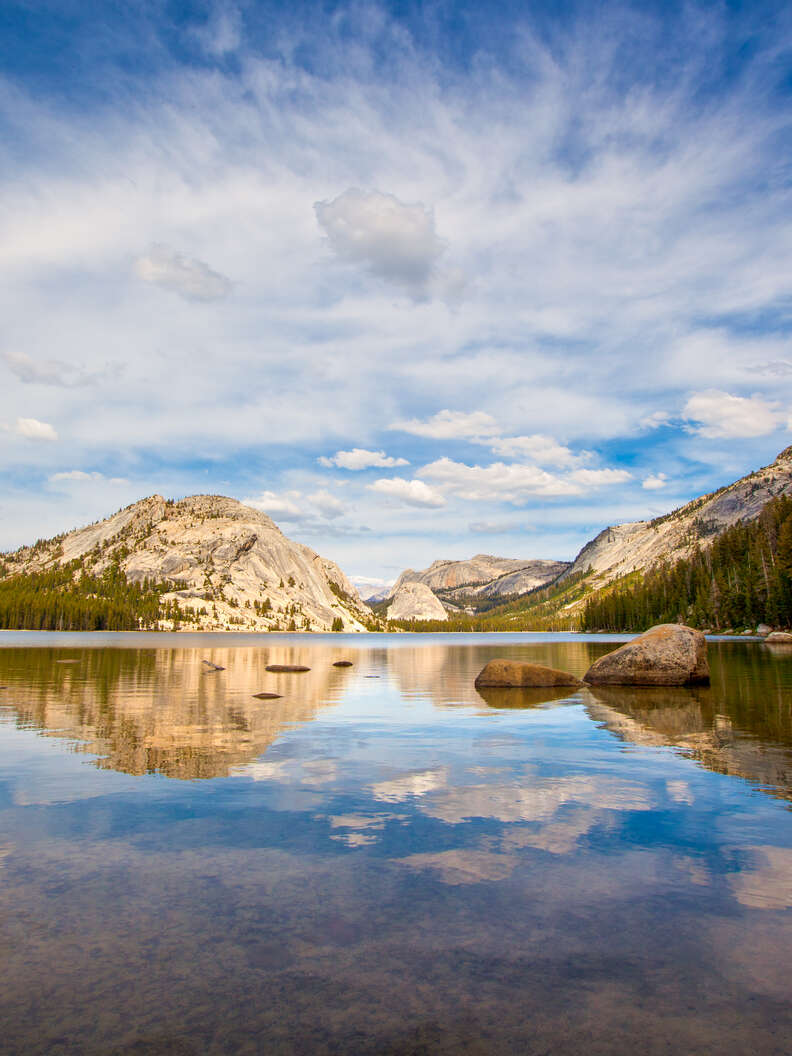The Most Beautiful Places in Yosemite National Park
There's scenic, then there's this.

For nearly 3,000 years, Yosemite has captivated every human who's been lucky enough to lay eyes on it. Of course, the Ahwahneechee natives who originally inhabited the park didn’t need to contend with millions of visitors every year just to get a nice view of Half Dome, but even today's crowds can't spoil this wonderland.
Arguably the most beautiful national park in the country, Yosemite is a paragon of America’s Best Idea. It’s a place of formidable landscapes, breathtaking waterfalls, towering granite rock formations, ancient giant sequoias, and vast unspoiled Alpine wilderness. There’s something gorgeous around every corner. Here are some of the essentials you don’t want to miss.
Editor’s note: As of October 1, 2021, you'll no longer need reservations to enter Yosemite. In response to the pandemic, some services are limited and shuttles remain closed. Click here for more information on current restrictions.

You can spot this 317-foot waterfall from the unforgettable Glacier Point (more on that later), but doing so means you’re missing out on the thrill of the iconic Mist Trail. The path actually brings you past two falls—Vernal is a relatively easy 1.5 mile trek in, while the 594-foot Nevada Fall is another 1.5 miles. Known together as “The Giant Staircase,” the falls provide the trail with its name, soaking hikers as they brave the slippery granite staircase. It’s worth the effort: the view from the top of Vernal is a stunner, and continuing on leads to the sparkling Emerald Pool and the Silver Apron, a smooth granite slope that looks just like a water slide (it is decidedly not actually a water slide). Definitely go early: This is a popular hike, and it’s best to do it when you don’t have to contend with crowds slipping all over the place.

The giant sequoias that populate Mariposa Grove aren’t just big trees: they’re among the oldest and most massive living things on Earth. This is home to some of America’s most famous trees, including the Grizzly Giant, which, at 210 feet, is the 25th tallest tree in the world and has been part of the grove for between 1,900 and 2,400 years. You’ll also encounter the Fallen Tunnel Tree, which had a tunnel for horse-drawn carriages cut through it in 1881. The grove’s accessibility means it’s crowded, but if you keep going through to the upper grove your strenuous hike will be rewarded with a more tranquil experience among the 500+ mature sequoias.

El Capitan—the 3,000-foot, 1.5-mile monolith that might just be the most famous granite rock in the world—is a national parks icon on the same level as Old Faithful. You know El Capitan. But even this enormous magnet for climbers—originally called To-tock-ah-noolah (“Rock Chief” or Captain”)—can still hold surprises. Come in rainy mid- to late-February and plunk down at the El Capitan Picnic Area on a clear evening before sunset, and you may just see the elusive “Horsetail Firefall.” At this time, the angle of the sun hits on the water from Horsetail Fall and turns it into a shining red cascade that looks like flowing lava.

These alpine lakes are among the most impressive you’ll find in the park, made extra serene thanks to their isolated location at the end of a crowd-thinning day hike. The trail, part of the 203-mile John Muir Trail, is an eight-mile round trip rewarded with not one but two lakes. It’s absolutely worth the effort just to see the reflection of Cathedral Peak in the waters of upper lake. To access this otherworldly area, you’ll need to hit the when Tioga Road is open… usually late May or June through October or November, depending on how much it snows.

At a knee-wobbling 620 feet, Bridalveil Fall isn’t even the biggest waterfall in Yosemite… not by a long shot. It is, however, the most iconic and accessible thanks to its positioning a half-mile down a paved road. Unlike some of the more fickle falls that are dependent upon wet weather to activate, Bridalveil flows all year long, though due to snowmelt it’s most intense in the spring. If you go when the wind is blowing hard, you’ll discover the reasons the Native Americans called this waterfall “Pohono” or "Spirit of the Puffing Wind,” as the water seemingly blows sideways. This also gives it the appearance of a veil, which… yeah, you’re all caught up.

This valley and reservoir in Northwestern Yosemite is overlooked by many, but that’s exactly why you want to go there. The wilderness in this part of the park is a particularly tranquil place to take in the lakes, streams, wildflowers, and wildlife that make their home between thousand-foot granite cliffs. With all of that beauty comes a little sadness: Hetch Hetchy is also home to a dam and reservoir that was approved in 1913 to deliver water to San Francisco (as it still does today) despite protests from environmentalists, including influential-but-controversial Sierra Club founder John Muir, who said, “Dam Hetch Hetchy? As well dam for water-tanks the people’s cathedrals and churches, for no holier temple has ever been consecrated by the heart of man.”

This 2,425-foot waterfall is the fifth-highest in the world, and the most famous of the thousands of falls in Yosemite (only 20 are named though). The water comes down with such force that the noise echoes through much of the valley in the spring, and the rainbow that surrounds it on sunny days is one of the most magical sights in the park. An all-day, highly strenuous hike will get you to the top, and March is typically when you'll see the most water. If you go in the summer or autumn, you may be disappointed: when the snow pack disappears, so does the fall.

To the east of El Capitan are three granite peaks called the “Three Brothers,” a name given to them by members of the Mariposa Battalion after they captured the three sons of the last chief of the Ahwahneechee at the base of the formation and killed the youngest. That’s pretty grim, which is why we much prefer the Ahwahneechee moniker: "Kom-po-pai-zes,” which translates to something along the lines of “mountains playing leap-frog.”
The uppermost “brother” is called Eagle Peak, and if you reach the summit you’ll enjoy what John Muir called “the most comprehensive of all the views” available from the north wall. To get there, you’ll need to hike nearly seven miles (one-way) with a climb of over 3,500 feet, which will pretty much take all day. If that sounds a little daunting, head to the Cathedral Beach Picnic Area instead where you’ll enjoy some of the park’s best views of the trio of siblings.

During six or seven months of the year, you can drive to this stupefying scenic overlook on the south wall 3,214 feet above Curry Village, stand where John Muir and Theodore Roosevelt once stood in 1903, and take in views of all the park’s greatest hits, including Half Dome, Yosemite Valley, Yosemite Falls, Vernal Fall, Nevada Fall, and Clouds Rest. Want to go in mid-December through march? You’ll have to strap on cross-country skis and cover 10.5-miles of snow-covered terrain. Just keep in mind, Glacier Point will be closed to all traffic for the entire 2022 season to rebuild the road.

Half Dome is Yosemite’s most recognizable formation due to its sheer face and three round sides (hence its name) that tower 4,737 feet above the valley floor. This monarch of the park is impressive from the ground, but the real gotta-do-it-before-you-die feat is climbing to its peak. To do that, you’ll need a hard-to-score permit and an aversion to vertigo, since the last part of the hike is a 400-foot ascent that requires you to cling to two bolted cables—a potentially deadly feat that about 30% of hikers turn back from. But make it to the top and you’ll experience 360-degree views of the Sierra Nevadas that words simply can’t explain.

Carved by the same glacier that created Half Dome, Tenaya Lake is a glassy alpine lake surrounded by granite peaks that is perhaps the park’s most beautiful body of water (hence its nickname, “the Jewel of High Country”). Located between Yosemite Valley and Tuolumne Meadows, Tenaya Lake is only accessible when Tioga Road is open (usually June through October). It’s right off of the road so it’s easily accessible and offers picnic tables, easy hikes, beaches with shallow waters for wading, and views you’ll never forget.

There may not be a more breathtaking view in the entire world than the one at this vista made famous by Ansel Adams. Towering 500 feet above the valley floor, Tunnel View lets you see a bunch of the Yosemite classics—El Capitan, Half Dome, Sentinel Dome, Cathedral Rocks, and Bridalveil Falls—all in one shot. Because it’s so easily accessible and because it’s so stunning, it can be quite crowded, but somehow when you’re standing at the edge taking it all in, it’s almost as if no one else is there.